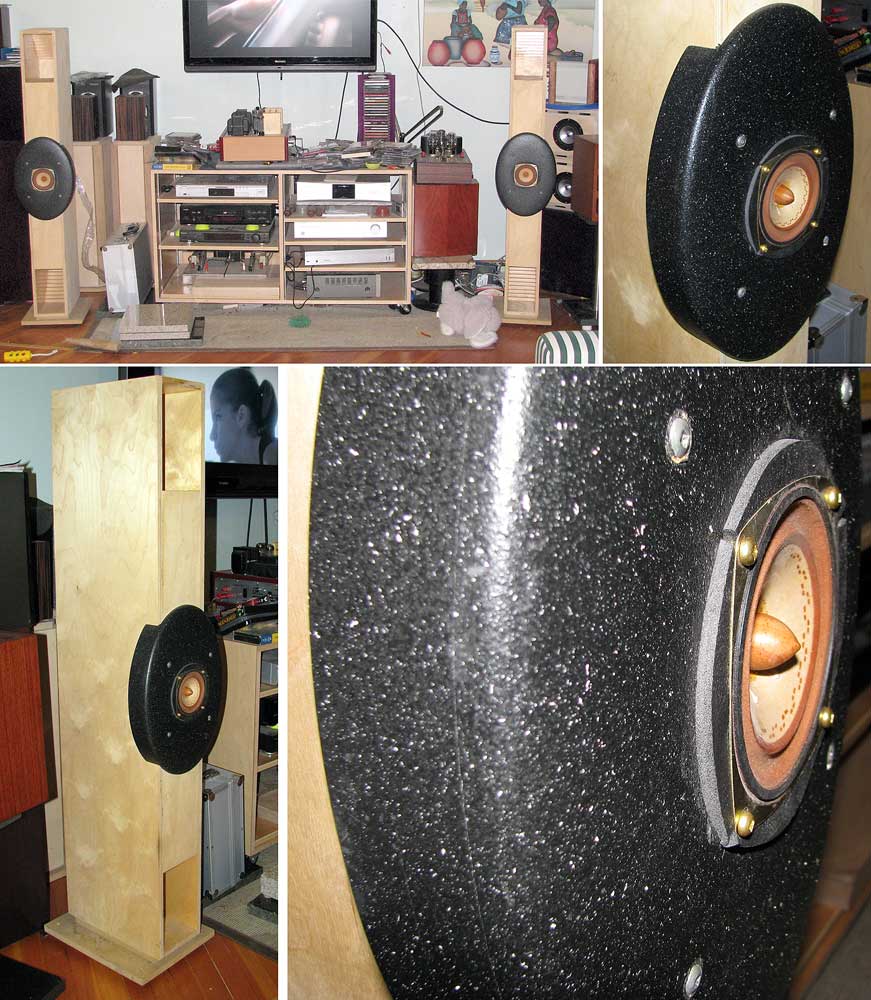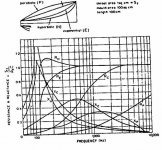Dig up a copy of Dinsdale's 3-part Wireless World (?) article -- there are copues of the pdf i made scattered all over -- as a good start. There are mistakes in it, but it gives you the broad strokes. A paper by Leach shows some math aimed at optimizing for efficiency. There are a few more useful articles, but in the end you just need to sit down with a modeler (i recommend MJK, but Horn Response and AJ Horn are also out there) and play. Once you start introducing folds (and even without folds) the math is pretty idealistic and gives out pretty quick.
dave
dave
morpheus82
Calculation of expo horns
If you have AH, AM, l,
k still lacks the flare rate:
ln (AM / AH) / l = k
so you can see the surface
each point out (Al):
INV ln (l * k) * AH = Al
l m, AH + AM + AL in square meters
By Al e.g. m in width and divide
you have the distance in meters
AH = Horn throat
AM = Horn mouth
k = flare rate
l = length
Lengths and flare rate VALUES
K VALUES:
0.37 ~ 10 Hz
0.55 ~ 15 Hz
0.7 ~ 19 Hz
0.9 ~ 25 Hz
1.1 ~ 30 Hz
1.3 ~ 35 Hz
1.48 ~ 40 Hz
About an octave above k plays the horn,
if the length matches. At BL horn lengths
over 3.4 m, you get a suck out
below 100 Hz
4/lamda lengths VALUES
3.4 m ~ 25 Hz
2.8 m ~ 30 Hz
2.4 m ~ 35 Hz
2.1 m ~ 40 Hz
1.7 m ~ 50 Hz
1.4 m ~ 60 Hz
Calculation of expo horns
If you have AH, AM, l,
k still lacks the flare rate:
ln (AM / AH) / l = k
so you can see the surface
each point out (Al):
INV ln (l * k) * AH = Al
l m, AH + AM + AL in square meters
By Al e.g. m in width and divide
you have the distance in meters
AH = Horn throat
AM = Horn mouth
k = flare rate
l = length
Lengths and flare rate VALUES
K VALUES:
0.37 ~ 10 Hz
0.55 ~ 15 Hz
0.7 ~ 19 Hz
0.9 ~ 25 Hz
1.1 ~ 30 Hz
1.3 ~ 35 Hz
1.48 ~ 40 Hz
About an octave above k plays the horn,
if the length matches. At BL horn lengths
over 3.4 m, you get a suck out
below 100 Hz
4/lamda lengths VALUES
3.4 m ~ 25 Hz
2.8 m ~ 30 Hz
2.4 m ~ 35 Hz
2.1 m ~ 40 Hz
1.7 m ~ 50 Hz
1.4 m ~ 60 Hz
Attachments
Hi Scott,
Assuming that one wants to learn "lots and lots," what might be a good starting point?
Right now, I can simulate something, but not design it (except in a rough trial-and-error sort of way, which doesn't count).
Assuming that one wants to learn "lots and lots," what might be a good starting point?
Right now, I can simulate something, but not design it (except in a rough trial-and-error sort of way, which doesn't count).
Dinsdale (yes, it was Wireless World BTW Dave) is a good introduction, error-riddled though the articles are. Leach & Keele are the top papers, but you better be prepared for some serious mathematical self-abuse, and of course, they assume uncompromised designs, so you have to know / figure out how best to use them.
Dinsdale (yes, it was Wireless World BTW Dave) is a good introduction, error-riddled though the articles are.
Dinsdale/3 parts
dave
Thanks guys, i'll start reading too...
Anyway, does anyone tried the "ML" software from Michael Zhang?
It's easy to use, but in the field "Vas" there is written to insert the value in m3, even if i think it's done for liters, becuase results are much more sensed in that case. Anyone tried?
Anyway, does anyone tried the "ML" software from Michael Zhang?
It's easy to use, but in the field "Vas" there is written to insert the value in m3, even if i think it's done for liters, becuase results are much more sensed in that case. Anyone tried?
I also tried to calculate the F0 of the Aiko cabinet. The mouth area from my calculations is 0,054m2. So this lead to a cutoff frequency of 200Hz from calculations. It it right? Isn't it too high?
No, it's not right. Aiko is good for ~80Hz. You are assuming a full sized uncompromised horn, impedance matched down to cut off. 99.9% of back-horns are compromised in terms of terminus area for fairly obvious reasons; that does not mean they have no LF output, it simply means below that impedance-matched point they rely on resonant action, the final LF cut off being a function of length and expansion profile, not terminus CSA.
morpheus82
Hello,
the formula take an optimum,
calculate a mouth for 40 Hz you will
see it is not particable, only
you will built a free flying bass horn for a
woodstock concert.
Hello,
the formula take an optimum,
calculate a mouth for 40 Hz you will
see it is not particable, only
you will built a free flying bass horn for a
woodstock concert.
hi guys, what do you think about this Aiko modification?
It is just a matter of aestethics. I like the the Chang shape, and the stacked pieces around the speaker, like in Mikasa.
This will shorten the horn about 11cm, but at the throat, the length will be increased by the added shape.
What do you think about it?
An externally hosted image should be here but it was not working when we last tested it.
It is just a matter of aestethics. I like the the Chang shape, and the stacked pieces around the speaker, like in Mikasa.
This will shorten the horn about 11cm, but at the throat, the length will be increased by the added shape.
What do you think about it?
hi guys, what do you think about this Aiko modification?
It is just a matter of aestethics. I like the the Chang shape, and the stacked pieces around the speaker, like in Mikasa.
You want me to be honest, right? The Curved Chang & Mikasa are very different boxes & combining the two in this way is likely to be an uneasy match. You may run into some dispersion / focusing problems.
This will shorten the horn about 11cm, but at the throat, the length will be increased by the added shape.
At the termini I think you mean. It's a considerable change in flare profile & total mouth size, which will naturally have a knock-on affect on the overall response in addition to the matters mentioned above. Which isn't to say I don't think you should try it. 😉 You might get lucky.
Thanks a lot Scott, I think it's nice to try, maybe i'll be happy with the results...🙂
The problem is that i don't have instruments to measure the response of the speaker, so you would have to believe my review...😉
The problem is that i don't have instruments to measure the response of the speaker, so you would have to believe my review...😉
My prediction is that you may get away with it if they're pushed into corners, but the aforementioned dispersion problems are likely to crop up.
Last edited:
ok, I got it.
Do you think it' is mostly related to the Chang shape?Or the reduction in the horn length?
Do you think it' is mostly related to the Chang shape?Or the reduction in the horn length?
I have FE103A in Aiko at the moment, and it is the best i've heard them -- and that with some undone tweaking to properly fit them. If you go ahead i'd start out with a larger air cavity, and fill as needed.

dave
Could I build a front portion similiar to this for my half-changs?
Would there be any benefit or any negative effects? Honestly, I just like the way the front portion of this enclosure looks.
Moving briefly OT, unlikely to have any real benefits (depends on circumstances) but assuming it's designed for the box, it won't do any harm.
ok, I got it.
Do you think it' is mostly related to the Chang shape?Or the reduction in the horn length?
You haven't really changed the length much, although you're certainly proposing a massive change in flare profile. It's because you're trying to combine two incompatible types of termini design.
- Status
- Not open for further replies.
- Home
- Loudspeakers
- Full Range
- Which double horn for a tb w4-657?
